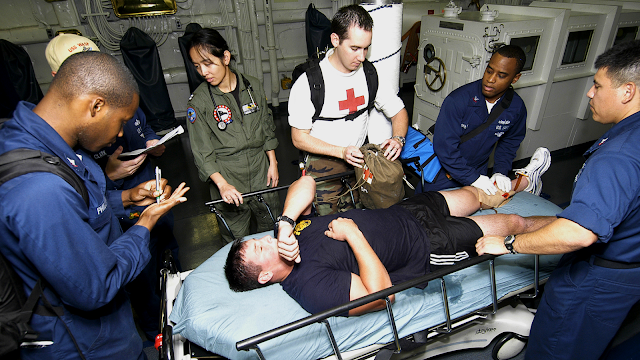It’s Not Just a Job, It’s an Adventure: Why USU Student Chose Navy for Career
By Ian Neligh
First-year Uniformed Services University of the Health Sciences (USU) medical student Nowa Bronner joined the Navy to help care for people while working in an exciting career.
“One thing that deterred me from going to [civilian] medical school after college and becoming a civilian doctor was I thought it lacked adventure,” Bronner says. “At the time, I was also thinking about joining the military, which interested me from the adventure perspective.”
Choosing an fulfilling career that allowed him both the opportunity to save lives and do something exciting was all it took to convince Bronner to join the Navy.
Starting Out
Throughout high school, Bronner focused on his dreams of playing soccer professionally, but once he was in college, he turned his attention to getting a major in engineering.
“But I think I realized I’d much rather work with people,” Bronner says. “That’s when I first started thinking about going into medicine.”
Once he discovered USU and learned that it offered him the opportunity to become a doctor and serve in the Navy at the same time, the decision was made. Bronner then attended the Navy Officer Development School in Newport, R.I. for five weeks, where he learned the responsibilities of a naval officer and the essentials of transitioning into the military.
At ODS, Bronner also learned about Navy customs and traditions, how to wear a uniform properly, and about the Navy’s core values. He was also introduced to the Navy physical fitness regimen: trainees were required to perform a set number of push-ups, planks, pass a swim test and complete a 1.5-mile run.
The Future
Before deciding to go to medical school, he says he considered training to become a pilot, in part because of his uncle who was a naval flight officer, something he says he still finds interesting.
However, Bronner says, “I thought becoming a flight surgeon was kind of a perfect mixture of letting me do a little piloting while practicing medicine. I could do medicine, work with people, and have adventure traveling in the Navy.”
The Navy provides its flight surgeons a six-week flight orientation and ground school at the Naval Aviation Schools Command, which includes land survival and water survival training.
Naval flight surgeons attend a ten-week flight indoctrination at Training Air Wing FIVE at Naval Air Station Whiting Field, Milton, Fla., where they learn to pilot a Bell Jet Ranger TH-57 helicopter and a fixed-wing Beechcraft T-6 Texan II. Flight surgeons treat injuries unique to military personnel working in aerospace environments, such as pilots.
 |
| The medical response team aboard multi-purpose amphibious assault ship USS Wasp (LHD 1) prepares to treat Petty Officer 1st Class Jeremy Sylvest, a Navy diver of the Norfolk-based Mobile Diving Salvage Unit 2 during a Diver Medical Evacuation exercise. The Navy's diving medical officers conduct physicals, diver injuries, and treat serious dive-related injuries while representing the Navy's diving community. (Photo credit: Chief Petty Officer Jeremy Siegrist) |
Additionally, Bronner says he is also considering becoming a diving medical officer after graduating, which would require him to become a fully qualified diver at the Navy’s Diving and Salvage Training Center in Panama City, Florida.
Diving medical officers conduct physicals and treat serious dive-related injuries while representing the Navy’s underwater community, which includes the Navy SEALS.
Besides serving as either a flight surgeon or diving medical officer, Bronner says he hopes one day to serve aboard either the USNS Mercy or USNS Comfort, the Navy’s two hospital ships, which support humanitarian missions and provide disaster relief worldwide.
Coming to USU, Ensign Bronner set out looking for excitement in the field of military medicine. When it came to choosing a service branch, Bronner couldn’t be happier with all of the paths afforded to him by the Navy, and all of the adventures yet to come.






